Japanese Soup Recipes: Warm & Comforting
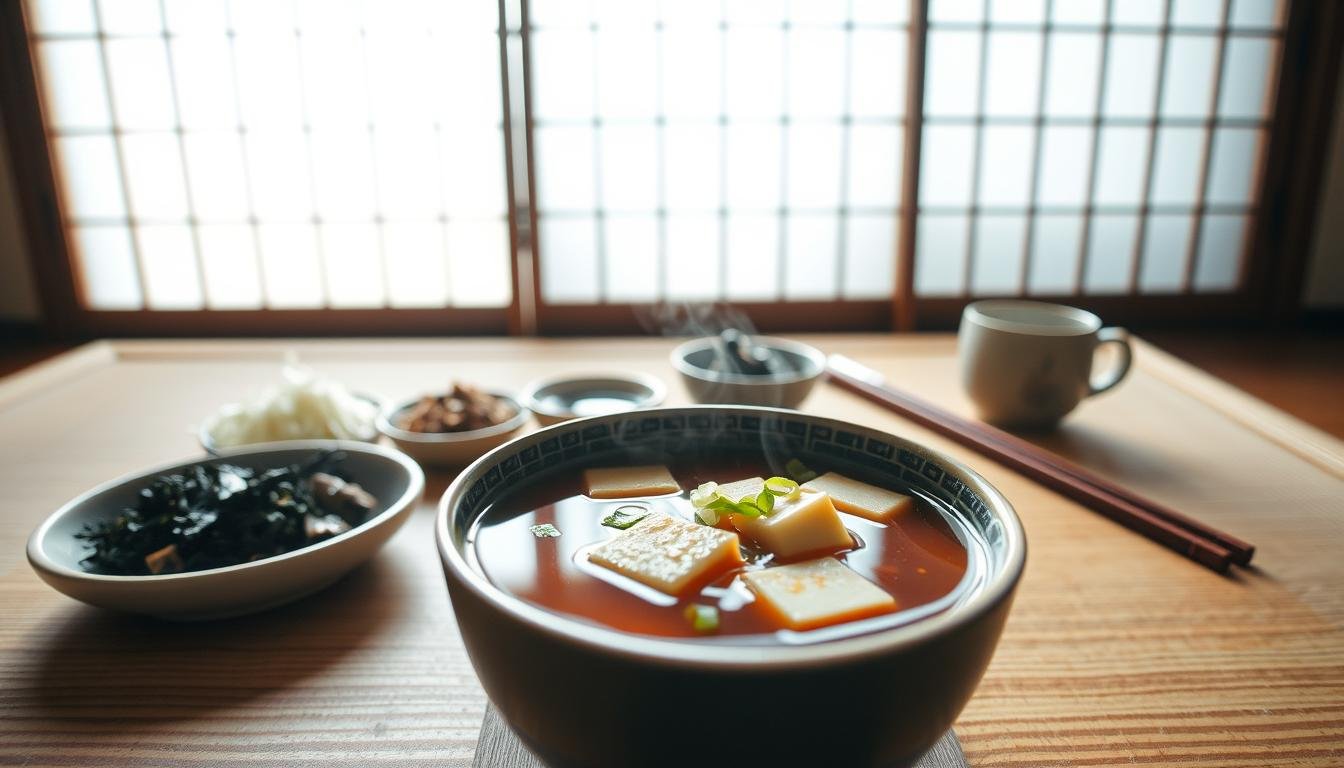
Have you ever wondered why Japanese soups are loved as comfort foods and health boosters?
Explore the world of Japanese soup recipes. They are a big part of Japanese food, known for being warm and comforting. These soups are a mix of flavors, easy to make, and good for you. You’ll find classics like miso soup and new ideas like cold miso soup.
These soups are great for everyone, whether you like meat or veggies. They are easy to make, making them perfect for healthy meals at home. Japanese cooking is known for its rich flavors and easy recipes.
Miso soup is full of good stuff like minerals and probiotics. Kenchinjiru is clear and balanced, making you feel good. You can also try soups from places like Hokkaido and Okinawa, with their own special ingredients.
Looking for a quick soup or something with lots of protein? Japanese soups have many easy recipes for any time. Start making these soups to enjoy the flavors of Japan in your own kitchen.
Get ready to learn about the best Japanese soup recipes, techniques, and tips. Are you ready to make a warm, comforting bowl of soup at home?
Introduction to Japanese Soups
Japanese soups are very important in their culture. They are part of daily meals and special events. These soups show the balance and harmony of Japanese food.
The Cultural Significance of Soup in Japan
Soup is a big part of Japanese meals. It’s eaten at breakfast, lunch, and dinner. Soups like miso and glass noodle soups are loved for their health benefits and taste.
Soba noodles are eaten during New Year’s. They mean long life and good luck. Udon noodle soups are warm and comforting, perfect for cold months.
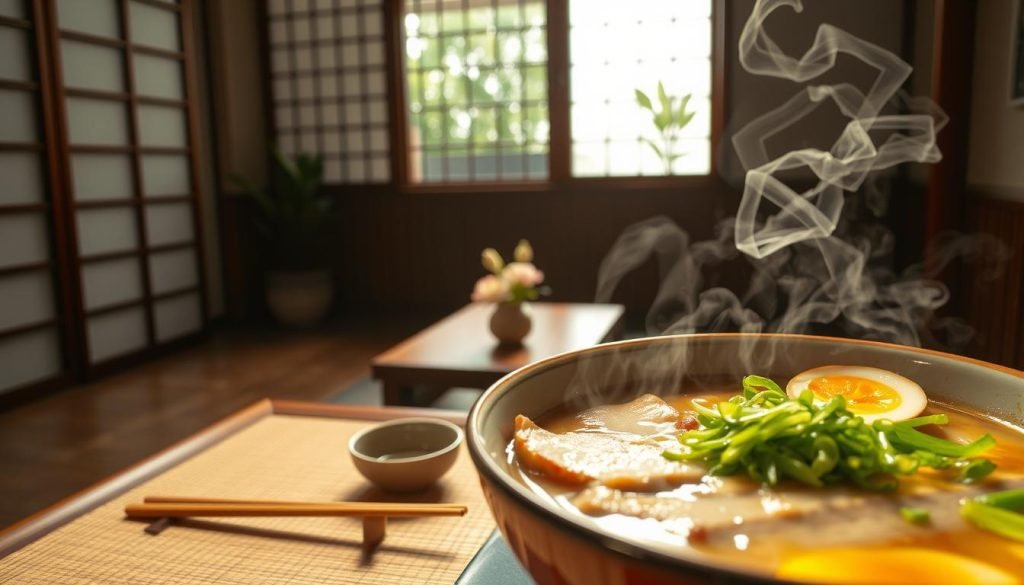
Key Ingredients for Authentic Soups
Real Japanese soups have special ingredients. Dashi, a broth from seaweed and flakes, is key. Tofu adds protein and a soft taste. Seaweed boosts the umami flavor.
These ingredients make the soups nourishing and true to Japanese food.
Common Cooking Techniques
Japanese soups use many cooking ways. Quick simmering makes light soups like miso. Slow cooking makes rich broths for soups like tonjiru.
- Simmering: Light soups like miso are quickly simmered to retain the delicate flavors of tofu and seaweed.
- Slow Cooking: Robust broths for soups like tonjiru are slow-cooked to infuse flavor from root vegetables and meats.
| Technique | Best For |
|---|---|
| Simmering | Miso soup, glass noodle soup |
| Slow Cooking | Tonjiru, chanko nabe |
| Steaming | Yudofu, suimono |
Knowing these cooking ways is key for making Japanese food. Each method highlights the special qualities of ingredients like tofu, dashi, and seaweed. This makes the food healthy and tasty.
Popular Types of Japanese Soups
Japanese soups come in many flavors and textures. They show the country’s rich food culture. Let’s look at three popular soups that show Japanese cuisine’s variety and depth.
Miso Soup: A Staple Dish
Miso soup is a key part of Japanese meals. It fits the idea of ichijū-sansai, or “one soup, three sides.” Its flavors are funky, sweet, salty, and umami.
Ingredients like dashi, tofu, and wakame create a taste symphony. This is why miso soup is loved in Japan.
Ramen: More Than Just Noodles

Ramen has become a global comfort food. It ranges from Tonkotsu ramen to Shio ramen. Each type has its own flavor.
Traditional ramen broth takes 12 hours to make. This shows the effort in making a real bowl of ramen.
Tonjiru: A Hearty Root Vegetable Soup
Tonjiru, or butajiru, is a hearty soup. It has pork belly and root vegetables like daikon and carrot. Ginger and sesame oil add to its flavor.
Dashi and miso stock make it rich and complex. It’s a favorite for a warm and nutritious meal.
| Soup Type | Main Ingredients | Key Components | Cultural Significance |
|---|---|---|---|
| Miso Soup | Dashi, Tofu, Wakame, Miso | Funky, Sweet, Salty, Umami | Staple in Japanese Cuisine |
| Ramen | Noodles, Broth (Various Types), Pork, Scallions | Rich, Savory, Versatile | Global Popularity |
| Tonjiru | Pork Belly, Daikon, Carrot, Ginger, Sesame Oil, Miso | Hearty, Complex, Nutrient-Rich | Cold Weather Favorite |
Exploring miso soup, ramen, and tonjiru shows the variety of Japanese soups. These recipes offer many culinary experiences. They are worth trying for a comforting meal.
Essential Japanese Seasonings and Condiments
To master Japanese soups, you need to know the key seasonings and condiments. These add depth and complexity to dishes.
Soy Sauce: A Flavor Enhancer
Soy sauce is key in Japanese cooking. It adds a savory depth to soups and more. It’s made from soybeans, wheat, salt, and fermenting agents.
It’s not just for seasoning. Soy sauce is also used in dipping sauces like ponzu. Ponzu mixes citrus, soy sauce, mirin, and dashi for a tangy flavor.
Mirin: Adding Sweetness
Mirin is a sweet rice wine that adds a delicate sweetness. It’s not like sugar, but it has a subtle umami flavor. This makes dishes balanced.
Its syrupy texture is great for glazes, broths, and marinades. Mirin is key in many sauces and soup bases. It’s essential in the Japanese kitchen.
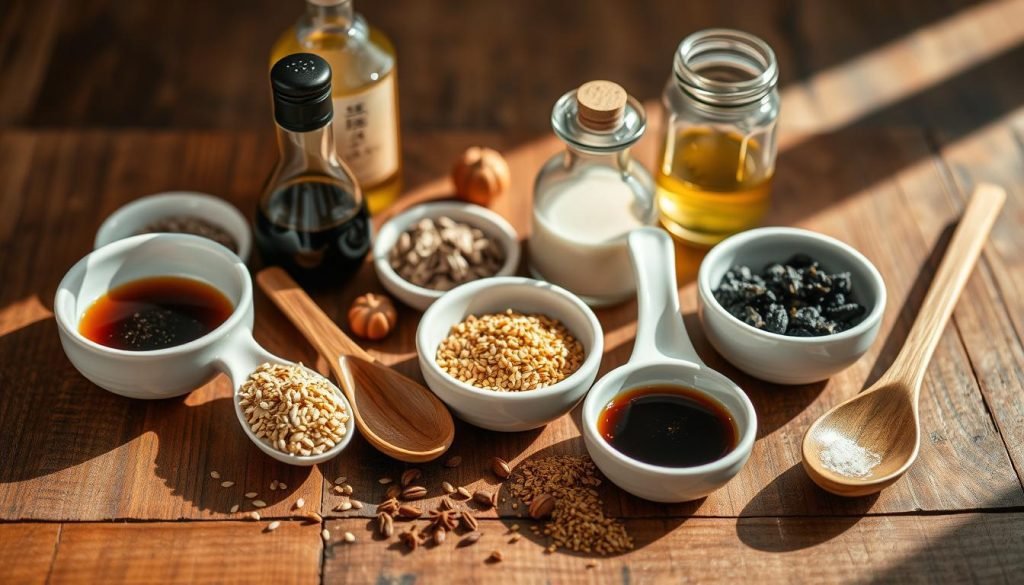
Dashi: The Building Block of Flavor
Dashi is a must-mention in Japanese seasonings. It’s a broth made from kombu (kelp) and bonito flakes (katsuobushi). This broth adds umami to many soups, like miso soup.
Whether homemade or from instant granules, dashi enriches flavors. It’s vital for authentic Japanese soups.
Knowing these condiments and seasonings is key for chefs. Soy sauce, mirin, and dashi create a perfect balance. They offer a satisfying taste every time.
Step-by-Step Guide to Making Miso Soup
Making miso soup is fun and brings comfort and health. This guide will show you how to make a classic recipe. You’ll also learn how to add your own twist and toppings. It’s perfect for those who want to try something new and delicious.
Traditional Miso Soup Recipe
This recipe makes four servings and takes only 20 minutes. It uses simple ingredients for a true taste.
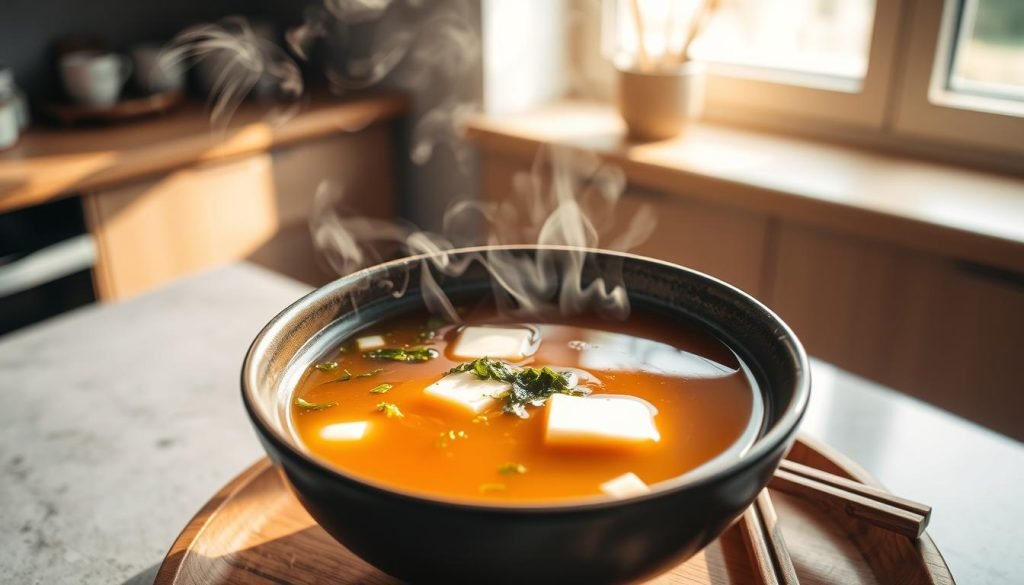
- Prep the Ingredients: Soak 3 tablespoons of dried wakame seaweed in water for at least 5 minutes. Cube 6 ounces of silken tofu and chop ⅓ cup of green onions.
- Make the Dashi Base: In a pot, combine 4 cups of water with a 1 (3-inch) piece of kombu. Simmer for 10 minutes without boiling to extract flavor.
- Add Dashi Granules: Dissolve 2 teaspoons of dashi granules into the simmering water.
- Mix in Miso: Lower the heat and whisk in ¼ cup of white miso paste. Make sure the miso doesn’t boil to keep its good bacteria.
- Combine Ingredients: Stir in the soaked wakame, cubed tofu, and chopped green onions. Simmer for 1 to 2 minutes and serve right away.
Variations to Try
Try these variations for a unique twist on traditional Japanese food:
- Seafood Miso Soup: Add shrimp or clams with the tofu for a sea flavor.
- Vegetable Medley: Add sliced mushrooms, carrots, or spinach for extra nutrients.
- Spicy Miso Soup: Mix in a teaspoon of chili paste or powder for a spicy taste.
Topping Ideas for Extra Flavor
Make your miso soup even better with these tasty toppings:
- Sesame Seeds: Sprinkle toasted sesame seeds for a nutty flavor.
- Nori Strips: Add thin strips of nori for a crunchy texture.
- Soft-Boiled Egg: A halved soft-boiled egg adds richness and protein.
Exploring Ramen Broths
Ramen soup is the base of the dish, affecting flavors and textures. The broth, called dashi, comes from pork bones, chicken, seafood, and veggies. These are simmered for hours. Let’s look at the different ramen broths, like shoyu, tonkotsu, and shio.
Shoyu Ramen: Soy Sauce Broth
Shoyu ramen is a favorite from Tokyo. Its soy sauce broth is savory and umami. It uses pork for the soup, but can also have chicken or fish.
The Asahikawa version has thicker noodles and pork lard. This makes it heartier than Tokyo’s. Shoyu ramen is adaptable and loved by many.
Tonkotsu Ramen: Rich Pork Broth
Tonkotsu ramen is creamy and rich. It’s made by cooking pork bones for 12 hours or more. This creates a milky broth.
It’s also known as Hakata ramen, from Fukuoka. Ingredients like Koumi abura add to its aroma. Yamachan Ramen offers soup bases, including tonkotsu, for quick flavors.
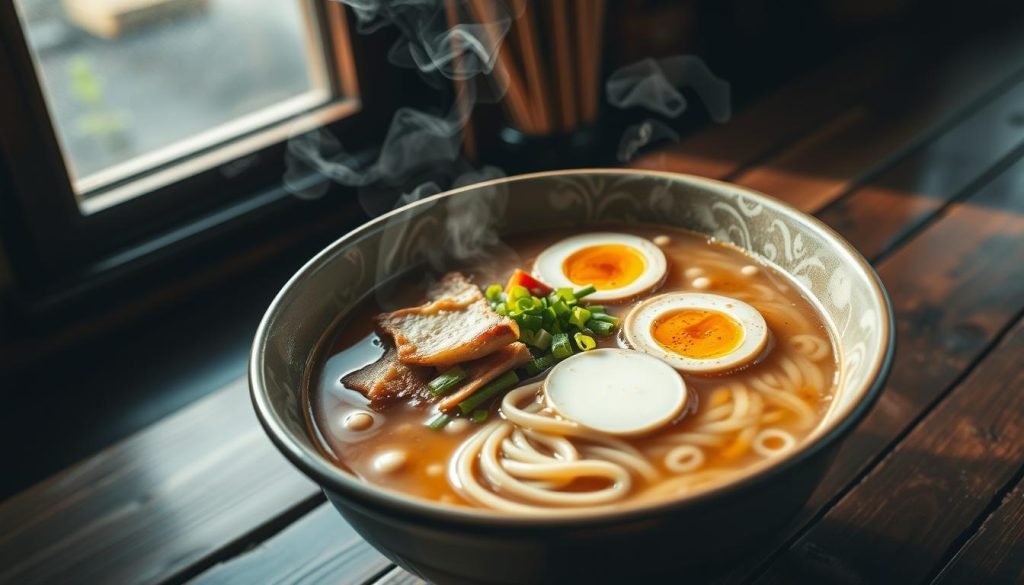
Shio Ramen: The Saltier Option
Shio ramen is lighter in color and taste. It comes from Hakodate. The broth is clear and slightly salty, showing off its ingredients.
It often has seafood dashi for a delicate umami. New options like chicken (tori paitan) ramen are rich and pork-free, like tonkotsu.
| Ramen Type | Main Ingredients | Characteristics |
|---|---|---|
| Shoyu Ramen | Pork, Soy Sauce | Umami-rich, versatile |
| Tonkotsu Ramen | Pork Bones | Rich, creamy, popular globally |
| Shio Ramen | Seafood, Salt | Light, clear, delicate |
Regional Japanese Soups You Should Know
Exploring regional Japanese soups is like going on a tasty journey across Japan. You’ll find soups filled with seafood in Hokkaido, sweet flavors in Okinawa, and vegetarian dishes in Kyoto. Each soup tells a story of local ingredients and cooking traditions, showing the heart of Asian food.
Hokkaido’s Seafood Soup
Hokkaido, Japan’s northern island, is famous for its seafood. Its seafood soup has crab, shrimp, and scallops. It’s made with a miso or soy broth, warming you up in the cold.
Ohaw, a traditional soup, uses natural flavors without miso or soy sauce. It’s a special soup from the Ainu people.
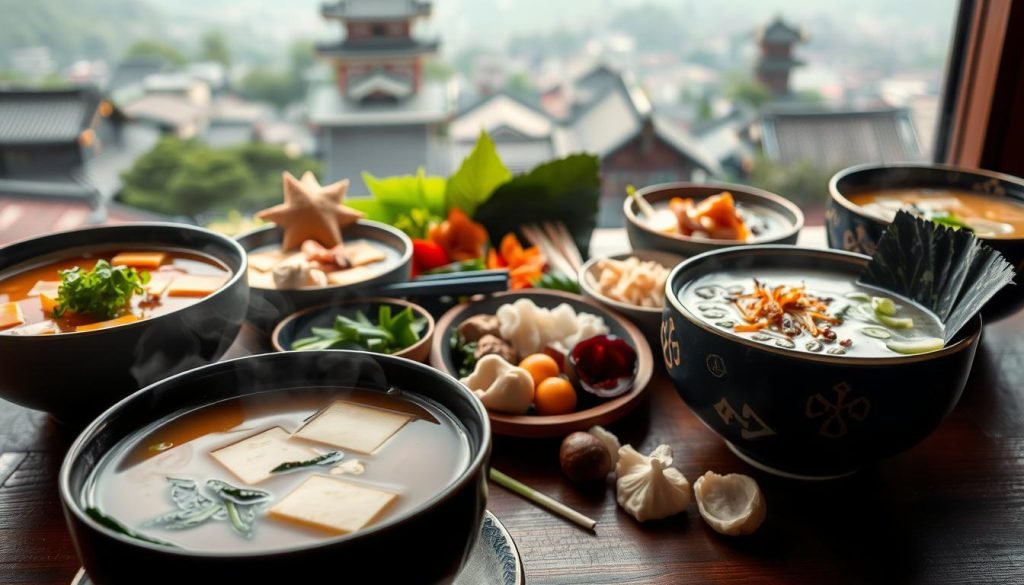
Okinawan Sōki Soba Soup
Okinawa, Japan’s south, has a comforting soup called sōki soba. It has thick noodles and tender pork ribs. The broth is light but full of flavor, mixing Japanese and Okinawan tastes.
This soup shows Okinawa’s creativity with local ingredients.
Kyoto’s Yudofu Soup
Kyoto, with its temples and gardens, offers yudofu soup. It’s a simple tofu dish in a hot kombu seaweed broth. It’s a calm and nourishing meal, perfect for cold months or special events.
These soups give a peek into Japan’s rich food culture. They offer a mix of flavors and history, making your food journey special.
Seasonal Japanese Soups for Year-Round Enjoyment
Exploring seasonal Japanese soups shows a mix of tradition and nature. Each season’s ingredients turn into warm, tasty bowls. From summer to winter, Japanese soups match the season’s energy and freshness.
Summer Soups: Light and Refreshing
In summer, Japanese soups are cool and light. Hiyashi Chuka is a favorite, with its chilled noodles and fresh toppings. Hiyajiru, a cold miso soup, is also popular. It’s served over rice and has cucumber and tofu for cooling.
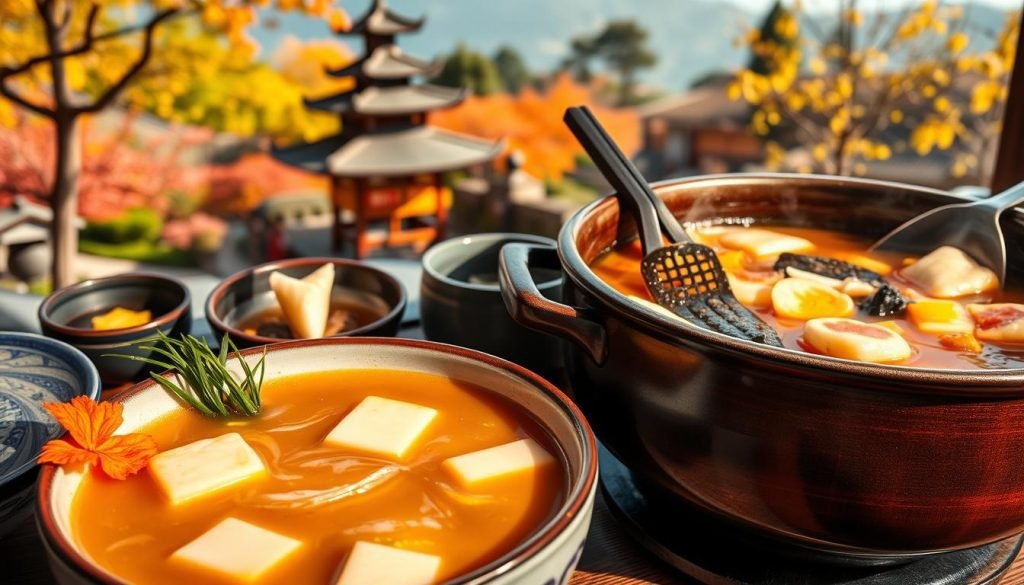
Autumn Soups: Comforting and Warm
Autumn brings soups that are warm and comforting. Kabocha soup is creamy and nourishing, made from Japanese winter squash. Tonjiru, a pork and vegetable soup, is also loved in autumn. It’s full of root vegetables that show autumn’s earthy side.
Winter Soups: Hearty and Filling
Winter soups are warm and filling. Ozoni is a winter favorite, enjoyed during the New Year. It has mochi and various ingredients, like soy sauce in Kanto or white miso in Kansai. Ohaw is another winter soup, with rich broths and local meats like salmon and venison. These soups not only warm you up but also celebrate tradition.
| Season | Popular Soups | Key Ingredients |
|---|---|---|
| Summer | Hiyashi Chuka, Hiyajiru | Noodles, Cucumber, Tofu |
| Autumn | Kabocha Soup, Tonjiru | Winter Squash, Pork, Root Vegetables |
| Winter | Ozoni, Ohaw | Mochi, Salmon, Venison |
Vegetarian and Vegan Japanese Soup Options
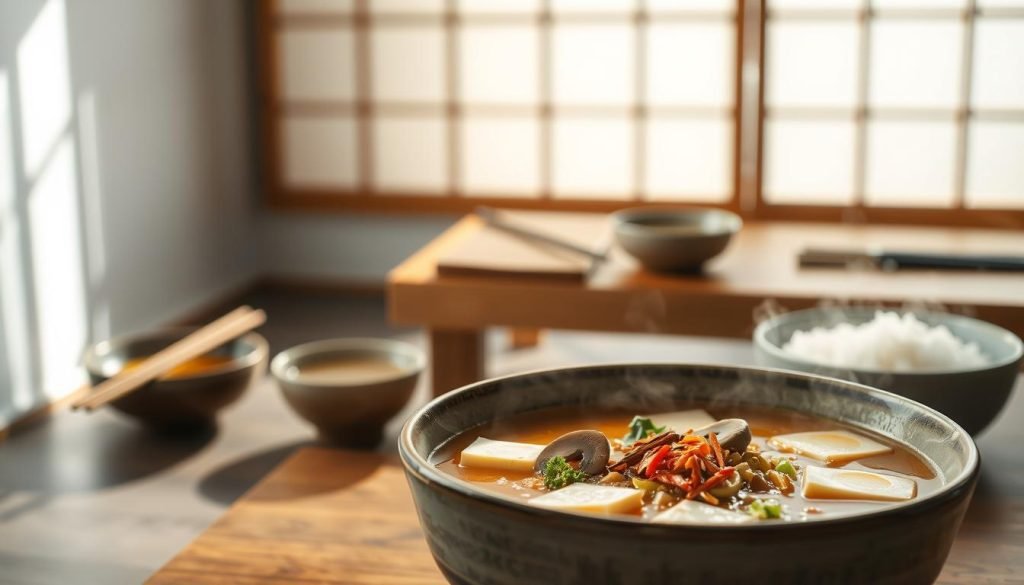
Japanese cuisine has many tasty vegetarian and vegan soups. They are full of nutritious veggies and flavorful broths. Let’s look at three great options: Plant-Based Miso Soup, Vegan Ramen, and Tofu and Vegetable Soups.
Plant-Based Miso Soup
Plant-Based Miso Soup is a warm, tasty dish for vegetarians and vegans. It has miso, kombu, and veggies for flavor. Tofu adds protein, making it a quick and satisfying meal.
When making this soup, simmer it gently. This keeps the miso’s probiotics safe.
Vegan Ramen for Everyone
Vegan Ramen is loved by many. It has a broth from soy sauce and kombu. It also has veggies and tofu for nutrition and taste.
This ramen is a complete meal. It’s great for those who want a vegan ramen without missing out.
Tofu and Vegetable Soups
Kenchinjiru is a hearty, nutritious vegan soup. It has carrots, burdock, daikon, and taro. The broth is made with mushrooms and kombu.
Tofu adds protein, making it a quick, healthy meal. Here’s what it has in each serving:
| Nutritional Content (per serving) | Amount |
|---|---|
| Calories | 258 kcal |
| Carbohydrates | 30 g |
| Protein | 13 g |
| Fat | 8 g |
| Saturated Fat | 1 g |
| Sodium | 1142 mg |
| Fiber | 7 g |
| Vitamin A | 5876 IU |
| Vitamin C | 14 mg |
| Calcium | 168 mg |
| Iron | 2 mg |
These soups use tofu and many veggies. They are delicious and full of nutrients. Enjoy Japanese soups that fit your vegetarian or vegan diet.
Tips for Perfecting Japanese Soups at Home
Making Japanese soups at home is fun and rewarding. You need the right ingredients, to know about umami, and to cook well. This way, you can make delicious and comforting dishes.
Choosing the Right Ingredients
The key to a great Japanese soup is the ingredients. Miso soup is very popular, but it needs careful making. The dashi broth, made from water, kombu, and katsuobushi, must be just right.
Fresh veggies like carrots and daikon are important for soups like Tonjiru. They make the soup hearty. Using firm tofu keeps the soup’s texture good. And, veggies from your area add real flavor.
The Importance of Umami
Umami, the fifth taste, is very important in Japanese soups. Miso, made from soybeans, adds a lot of umami. The color and type of miso change the soup’s taste.
Kenchinjiru, a veggie soup, gets umami from mushrooms and kombu. This shows you can use different ingredients to get umami. Finding the right mix of umami ingredients makes your soup taste deep and complex.
Cooking Techniques for Flavor Development
Good cooking techniques are key to making your soups great. Skimming the scum off while boiling is important for clear soup. It takes about 5-10 minutes to do this.
When making miso soup, mix the miso paste gently into the broth. This makes the soup smooth and flavorful. Trying different ingredients and recipes can help you make your own special soup. You can make dashi at home in 30 minutes. Or, use instant dashi for a quick option without losing flavor.